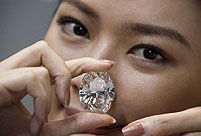Romeo and Juliet,” arguably Shakespeare’s best-known and most-performed play, has found its way back to Broadway after 36 years, albeit in a modern-day version that has a black actress playing Juliet, but the revival of the tragedy about two young star-crossed lovers whose deaths ultimately reconcile their feuding families is making waves among critics.
Less known is “The Peony Pavilion,” an equally passionate play that bears remarkable similarities to the imagination of Shakespeare.
Penned by Tang Xianzu, a retired court official of the Ming Dynasty (1368-1644) who died the same year as Shakespeare (1616), his masterpiece has been translated into English and performed in the West several times.
Both authors relied on supernatural forces to advance their plots. The Flower Goddess, for instance, who brought the dream lovers together in “The Peony Pavilion,” is almost interchangeable with Puck in “A Midsummer Night’s Dream” or Twith Ariel in “The Tempest.”
“Peony Pavilion is so much more than a love story,” noted Xianzu specialist professor Andrea Goldman, who earned her doctorate at Berkeley and teaches Chinese history at the University of Maryland.
“It’s also a scathing indictment of the limitations of the super-rationalist, but rather clueless, world of Neo-Confucian politics. In launching his critique of society, Xianzu, like many of his contemporaries, also borrowed freely from Buddhist and Daoist philosophical concepts. After all, Du Liniang’s love is so strong that it has the power to last three lifetimes — and karmic rebirth was a notion drawn from the Buddhist tradition.”
Indeed, what you should know first and foremost about “The Peony Pavilion,” a 16th-century Chinese musical drama about love, death, and resurrection — and arguably the most famous of all Kunqu Operas — is that its poetry can kill. It has killed before.
Passion is its currency, and when expressed through kunqu — a sophisticated theatrical art form that fuses poetry, dance, and refined woodwind ensemble, not to mention fabulous costumes and makeup — and with a story line rivaling “Romeo and Juliet” — its performances literally stopped a few hearts in the audience during the late Ming Dynasty.
Why that is so is not difficult to understand. “The Peony Pavilion” was written in an era when China was going through a rigid, repressive style of Neo-Confucianism known as daoxue. It emphasized proper outward displays of behavior and rituals.
Living by the book became the ruling orthodoxy. This dismayed playwright Xianzu, a retired court official.

 Storms leave 97 dead, 58 missing in Mexico
Storms leave 97 dead, 58 missing in Mexico New model of indigenous surface-to-air missiles testfired
New model of indigenous surface-to-air missiles testfired  118.28-carat diamond to be auctioned in HK
118.28-carat diamond to be auctioned in HK Maternal love under streetlight
Maternal love under streetlight Naked foreign student sits in the middle of a road in Haikou
Naked foreign student sits in the middle of a road in Haikou  Colorful Yunnan: Enjoy the natural beauty
Colorful Yunnan: Enjoy the natural beauty Harbin named Chinese city with most beautiful women
Harbin named Chinese city with most beautiful women New college students' military training in Guangzhou
New college students' military training in Guangzhou Rugby girls
Rugby girls PLA's 38th Group Army conduct training
PLA's 38th Group Army conduct training Residences of the royal house of Savoy
Residences of the royal house of Savoy The last days of Wan Aihua
The last days of Wan Aihua Highlights at 12th National Games of China
Highlights at 12th National Games of China Beijing Film Academy welcomes freshmen
Beijing Film Academy welcomes freshmen Large mahjong party sets new world record
Large mahjong party sets new world recordDay|Week|Month